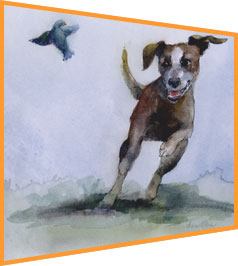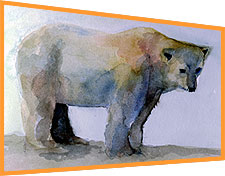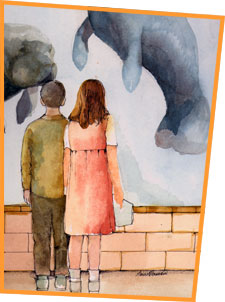Earth Action Stories: A Trip to the Zoo
Andrea
 and Evan sit side by side on the school bus as it chugs through the city streets on the way for a class trip to the zoo. and Evan sit side by side on the school bus as it chugs through the city streets on the way for a class trip to the zoo.
"My dog, Tiny, loves to chase birds in the backyard," Andrea tells Evan. "He likes to dig too. He gets in trouble when he digs up the yard. He digs up my mom's plants. She says if he keeps it up, he's going to have to find another home!"
"I've got a fish tank in my bedroom, and I know all of my fish by name," Evan replies. "At least they can't dig up the yard!"
Linda Dodd is the guide for the zoo. She meets the children at a picnic shelter inside the zoo's entrance.
"Do any of you have a favorite animal?" Linda asks the students after she introduces herself.
Andrea tells Linda about Tiny. Her classmates laugh when she says that Tiny is always in trouble for digging up the yard.
Linda laughs too. "I guess that's why you have a fence around your yard, so Tiny won't dig up the neighbor's flowers," she says. "Maybe Tiny should be in the zoo!"
The children laugh. "So, students, why do we keep animals in zoos?" Linda asks.
Lots of people answer.
"Those are all good answers," Linda says. "In zoos we try to give animals a habitat to live in that is just like theirs in the wild. Let me show you what I mean."
 With that the students followed behind in a line. They head up a short hill to the Polar Bear Arctic section of the zoo. Inside a large, round area are huge boulders, a small stream, and an icy pond. With that the students followed behind in a line. They head up a short hill to the Polar Bear Arctic section of the zoo. Inside a large, round area are huge boulders, a small stream, and an icy pond.
"What do we do to create the right habitat for the bears?" Linda asks.
"Scientists visit the animals where they live and watch them," Andrea replies.
"And scientists see what they eat and what other animals they live with too," Evan adds. He was thinking about some fish he had to take out of his tank because they were trying to eat the smaller fish.
"That's right. Zoos try hard to provide animals with their usual habitat," Linda says.
There were more questions as the students left the bears and walked to the Rainforest Jungle Trail. On the way there they passed through the Manatees River area, which is home to the manatees, an endangered species. Linda asks how scientists might know where to visit certain animals and what they would be looking for. And Evan wants to know what makes up a habitat.
 On the Rainforest Jungle Trail the students amble through leafy plants with broad leaves. A cool mist hangs over the trail. Flowers of deep blue, purple, and red add a splash of color against the deep greens that are everywhere. Mrs. Mahoney, Andrea and Evan's teacher, says some of the plants are ferns. On the Rainforest Jungle Trail the students amble through leafy plants with broad leaves. A cool mist hangs over the trail. Flowers of deep blue, purple, and red add a splash of color against the deep greens that are everywhere. Mrs. Mahoney, Andrea and Evan's teacher, says some of the plants are ferns.
"My mom has those hanging on our porch in big pots!" Andrea exclaims.
The animals are something to see too. There are bonobo chimpanzees, lemurs, and orangutans. Linda tells the students these animals are endangered.
At lunch Andrea and Evan ask Mrs. Mahoney what endangered means.
"Scientists observe many types of animals," Mrs. Mahoney tells the two. "They keep track of how many of some types of animals live in an area. Sometimes they find that there are fewer and fewer of some animals over the years. That's important for us to know. When we get back to school, we're going to explore rainforest habitats and learn about endangered animals that live there. You know, we people might be able to make a difference for these animals."
On the way back to school Andrea and Evan sit next to each other again. Evan wears a look of deep concern. He's been thinking about all that he had learned about habitats and how things like plants and animals live together. Suddenly, he turns to Andrea.
"Hey, Andrea, if Tiny keeps digging up your mom's flowers, is she going to make him an endangered species?"
Biomes Earth Action Problem 1: A Butterfly Garden (K-4)
As part of a school beautification project, your class has been asked to create a butterfly garden. You need to determine what plants will grow best in your community. You should also build a weather station. Knowing the weather in your area will help you determine how to care for your plants.
Biomes Earth Action Problem 2: An Addition to the Zoo (K-2)
Your local zoo would like to add a koala bear to their exhibits. You and your classmates have been asked to help the zookeeper prepare the habitat for the koala bear. What does the koala bear need to live in your community?
Biomes Earth Action Problem 3: Circus Train (3-4)
A train that carries the circus animals from town-to-town has broken down near your school. It may be several days or perhaps weeks before the train can be fixed. The circus owners need to find the proper environment in which to keep the animals the train is ready. They are most concerned about keeping the lions, tigers, camels, and elephants comfortable. Please make some suggestions. |
Earth action story written by Regina Wolterman. Artwork by Anne Foreman. |











